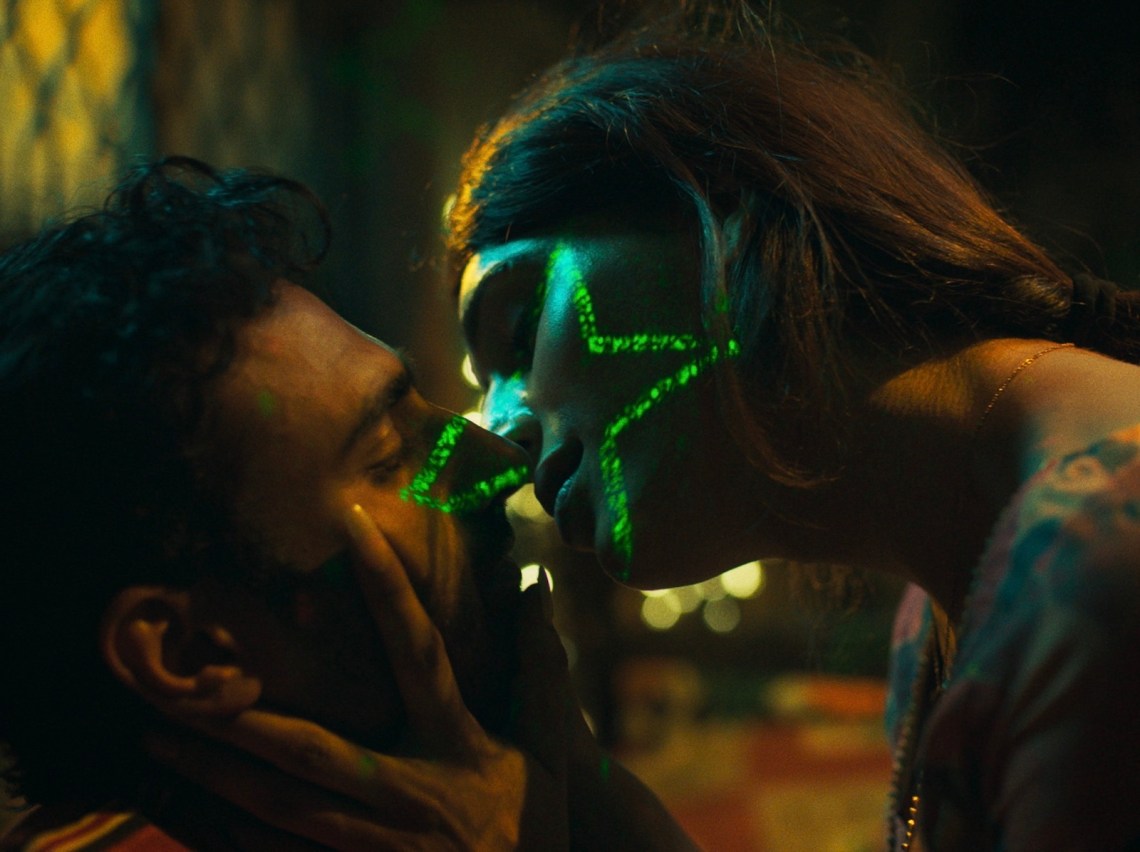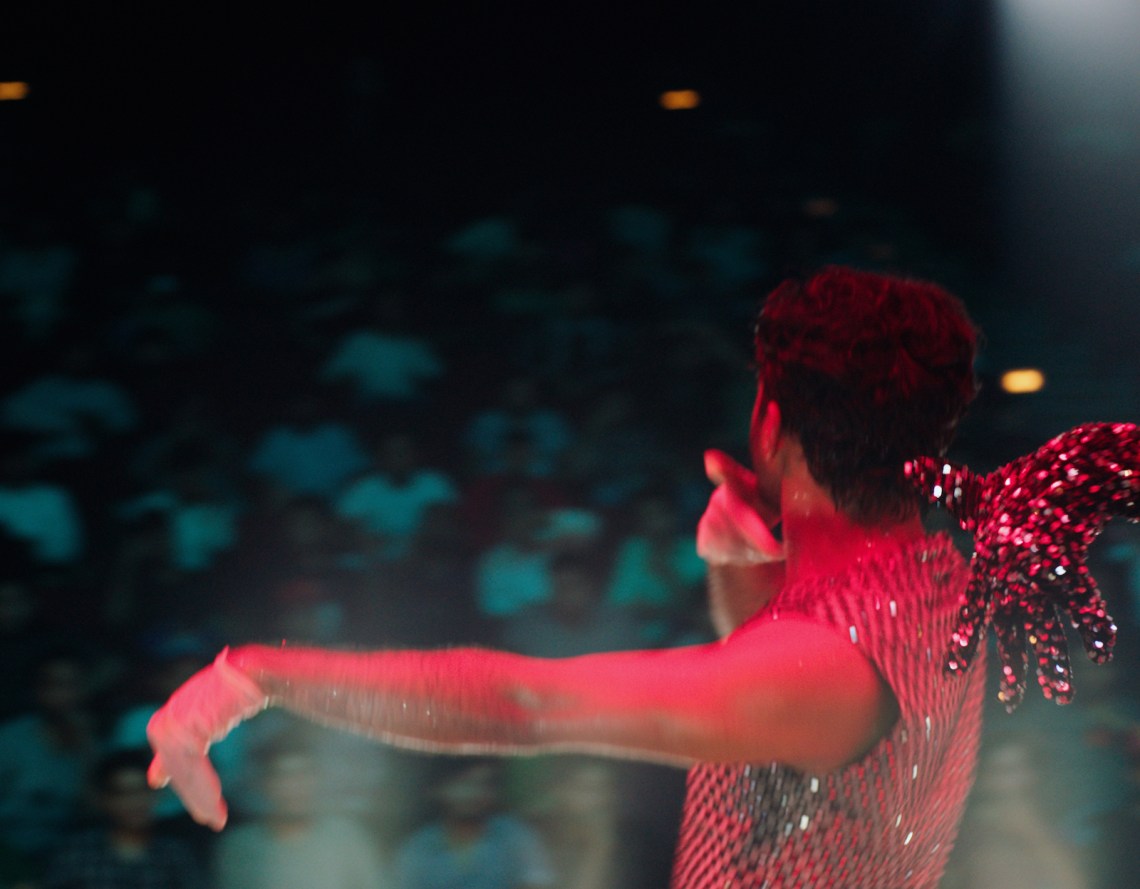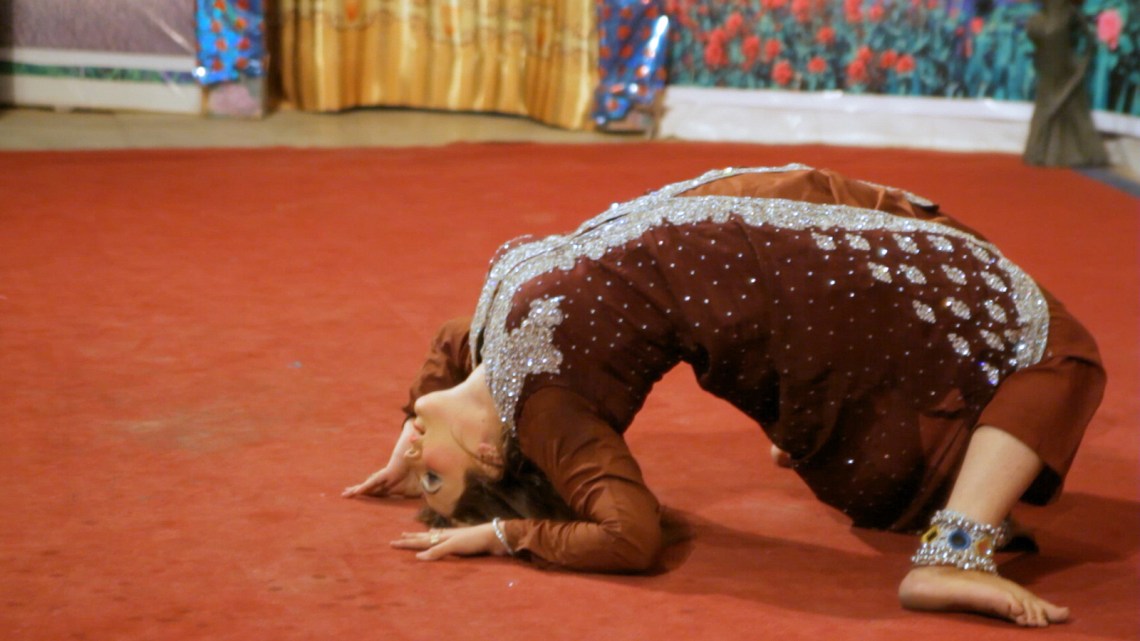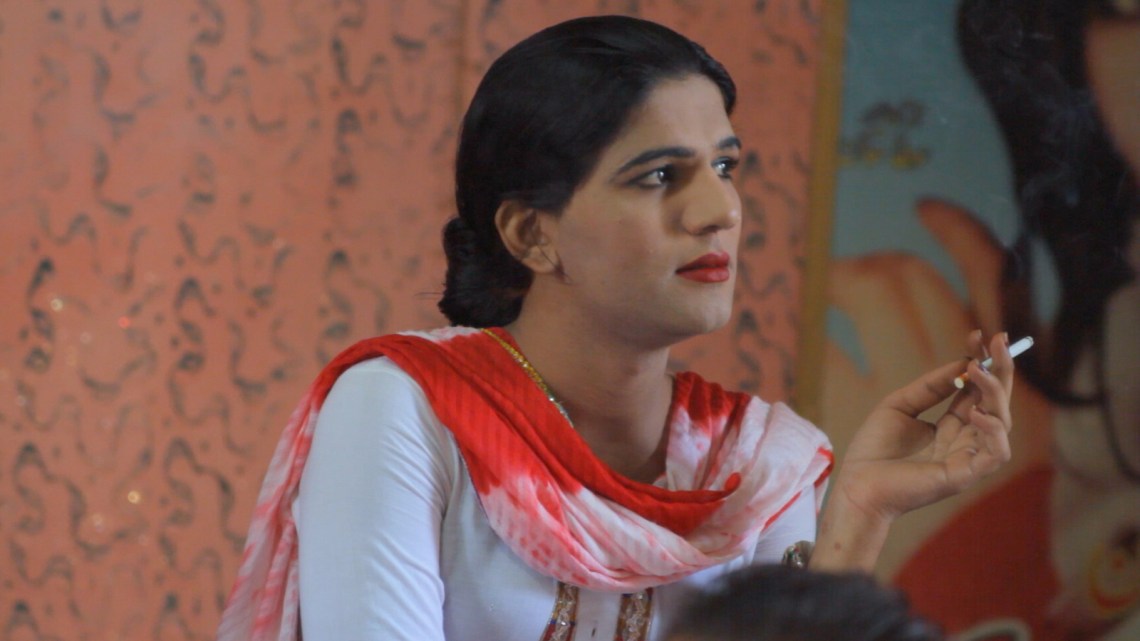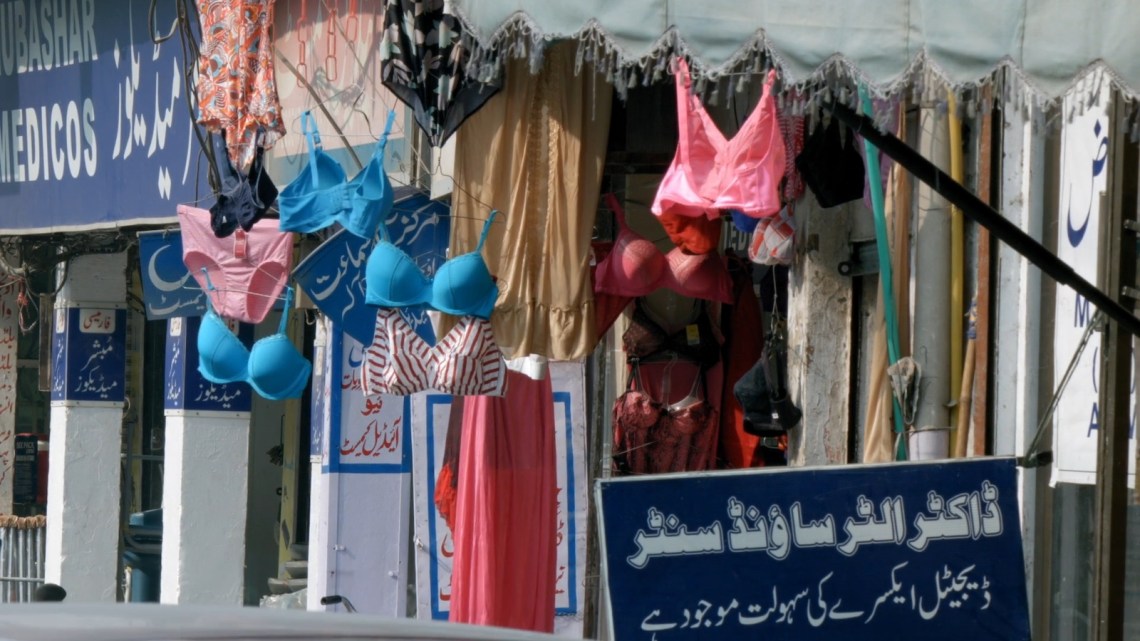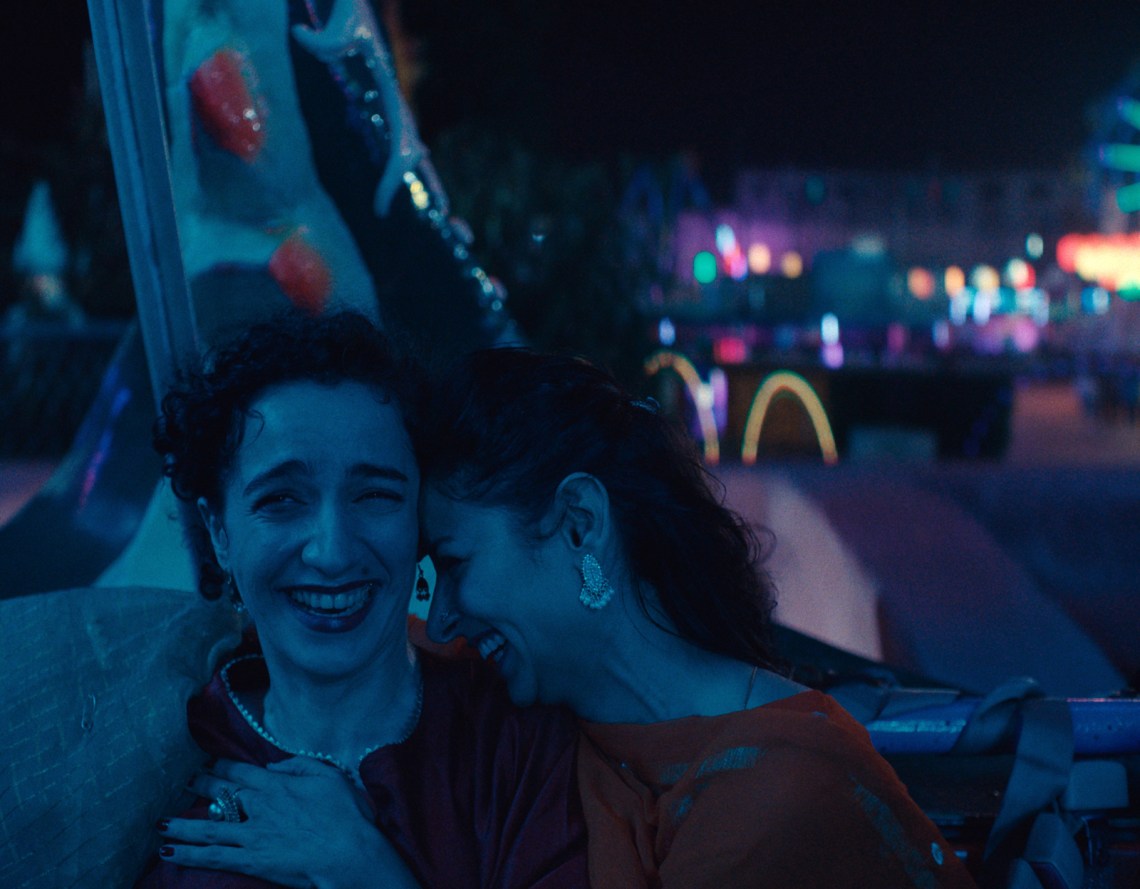In keeping with an old directorial tradition, Saim Sadiq—or, rather, the back of his head—makes a brief, uncredited appearance in Joyland, his debut feature about a skein of secret desires slowly unraveling in an old Lahore neighborhood. He plays the reproachful neighbor who shows up to mediate a supposed scandal: his mother, a widow who keeps loneliness at bay by fussing over the wheelchair-bound Mr. Rana (Salmaan Peerzada), spent the night at the old man’s house after her children forgot to escort her home. Nothing untoward happened, the son is assured, but that’s not the point. A woman alone with a strange man? It looks bad.
The scene opens with a close-up of a tray of untouched tea, then flits from person to person, a series of tight shots: Mr. Rana, his two sons, their wives, and Auntie Fayyaz (Sania Saeed), whose sleepover has sent her son into a tizzy. As Sadiq tsk-tsks his mother, we are reminded of a little kid clomping about in too-big boots. In a sense this entire impromptu tribunal is a skit, the characters doubling down to reinforce the social script: the younger women overly demure, the other men awkwardly conciliatory, trying to placate the man whose honor has ostensibly been outraged. But Auntie Fayyaz is done being cast as an old crone with an inappropriate crush. “I know what you all think of me,” she says. “A burden or a bhut.” Her son storms off, and she turns to Mr. Rana. “I could just stay.”
She could just stay. I found myself holding my breath. What makes desire so audacious—a destabilizing force in Joyland, and in our own lives—is that it dares us to reimagine the world, to take it apart and build it anew. But Mr. Rana wilts. He is too frightened, perhaps, or too embarrassed, to be anything other than the aloof, sexless head of his household. This is what interests Sadiq: how men too must quash their desires to keep patriarchy afloat. As a child, he told me when we spoke over Zoom in January, he struggled with the ways in which our families are our first oppressors. “Why am I not feeling OK with these things that are literally in the rulebook?” he asked himself. “And then I grew up and realized, oh, no one is feeling it’s OK. Not my mom. Not even my dad.”
*
To the extent it has one, Joyland’s central plotline is a different forbidden romance, between Haider (Ali Junejo), the younger Rana son, and Biba (Alina Khan), a khwaja sira performer trying to become a star in a seedy theater. They are both outsiders. Biba belongs to a historically marginalized community—in Pakistan, khwaja sira are typically intersex people or those assigned male at birth who do not consider themselves men, with many identifying as women—and is clawing for space in an industry of mostly cisgender women. Haider, gentle and acquiescent, who until recently handled caregiving responsibilities at home while his wife, Mumtaz (Rasti Farooq), worked at a beauty salon, has been inducted into this world of tenuous glamour as one of Biba’s background dancers.
In the run-up to its release in Pakistan in November, Joyland—which by then had received multiple international accolades, including a prize at Cannes—was caught in the crosshairs of a local antitrans campaign, which zeroed in on Haider’s romance with Biba and forced the country’s various censor boards to rescind their certifications. It isn’t the first film to be proscribed by the state: Zindagi Tamasha, the country’s 2020 submission to the Oscars, remains banned because its subject matter—a composer of paeans to the prophet goes viral for dancing to an “item number” at a wedding—enraged antiblasphemy activists; Jago Hua Savera, Pakistan’s first Oscars submission all the way back in 1959 and its only neorealist film, depicting the lives of indentured fishermen, also never showed locally. This time, though, Pakistanis who hadn’t succumbed to the current wave of transphobia in the country tweeted and posted in outrage against the directive, resulting in a partial reversal. (It remains banned in Lahore, where it is set.)
I first watched a censored version of Joyland in a multiplex in a mall in Karachi. Objectionable scenes had been redacted—Haider and Mumtaz embracing on a rooftop, Haider and Biba having sex, a furtive masturbation scene, a khwaja sira wedding—and I was struck by the state’s narrow notion of desire: anything suggesting the possibility of sex, basically. In Joyland desire is far more capacious. Midway through the film, in a scene that feels quietly pivotal, Haider and Biba lean against each other, looking away. The camera is upside-down, and they occupy the upper part of the frame. He is lost in thought, so lost he doesn’t hear Biba until she snaps her fingers; the frame rights itself, breaking the spell. “Sometimes I feel like I have nothing that’s my own,” Haider explains haltingly, fretful finger strumming lower lip. “Everything feels borrowed or stolen.” He isn’t quite as clear-eyed as Auntie Fayyaz, not yet at least, but he too longs for a different role.
Advertisement
Joyland is laced with this longing. As Auntie Fayyaz collects herself after Mr. Rana’s rejection, the camera lingers on her face, endowing her with great dignity. When Mumtaz sees her independence ebbing after Haider assumes his position as breadwinner, she tries to wrest it back by offering to buy air conditioners with her salary—money, she knows, can paper over many a middle-class hang-up, especially in a time of downward social mobility. When Haider looks at Biba—steely, sexy Biba, perhaps the farthest along in choosing her own role—it is with lust, but also as if she holds the key that could make life tolerable. In Pakistan, the furor over Joyland has focused on the permissibility of their romance, but Biba’s unapologetic existence is the real disruptive force. “A khwaja sira who has owned their identity and is visibly channeling it is the person with the most agency over themselves, their feelings, their desires,” Sadiq told me. “It’s a person who is being their true self—and that reminds us all of how we’re not.” Joyland deploys a different sort of male gaze, if I can call it that, one laced with envy and curiosity rather than possession—painfully aware that the men anointed to run the world are themselves utterly miserable.
*
This same searching quality imbues Saad Khan’s Showgirls of Pakistan, a 2020 documentary that follows three performers in the mujra world. Subtitles in Joyland oversimplify the term as “‘erotic dance”’; originally a form of courtly entertainment in precolonial India, the tradition was kicked to the margins under British rule, the courtesans dispossessed of royal patronage as their patrons were themselves cut to size. Mujra changed form and function over the centuries, and Khan has noted that over the past several decades a hypersexualized commercial version took root in Punjab, its clientele primarily working-class men.
With the advent of VHS tapes, then DVDs, and now live-streaming apps like TikTok and Bigo, its audience is no longer just those who flock to theaters; it includes migrants in the Middle East and those watching on unlicensed local cable. Khan and Sadiq, who both grew up in Lahore but come from different class backgrounds, have childhood memories of the men in their family watching mujra on cable. Sadiq remembers them scrambling to switch channels whenever he entered the room—mujra was deemed too crass for children and women. (In theaters in large cities, the state serves this paternalistic function, imposing fines or outright bans on performers if they show skin, or move too sexually, or interact with the audience.)
Mujra animates the world of Joyland—Biba is a mujra performer—but Sadiq is mainly occupied with the domestic dramas of middle-class Lahore: the oppressive, performative respectability of the traditional family unit. In Showgirls of Pakistan, mujra and its stars—those on the way up and those on the way down—take center stage: Afreen, who addresses her legions of “sweet, sweet fans” via frequent livestreams between stage acts, wiggling her painted toenails, blowing smoke rings at the camera; Uzma, who performs at private parties and is frequently shipped off to Dubai, where she spends her nights dancing at bars and her days under lock and key in a hotel room; and Reema, a khwaja sira stage veteran who now goes door-to-door blessing newborns and newlyweds, a traditional khwaja sira social role, since she is older and the once-steady stream of shows has dried up.
Partly because of the skewed economics of the industry, documentaries set in Pakistan have typically been caught between a savior complex and a tendency to exoticize—in a stray scene in Joyland, Biba rebuffs a German film crew asking her to recount the murder of a friend by a patron during a private performance, refusing to relive her trauma for someone else’s consumption. “Showgirls was the product of the jadedness and exhaustion I felt dealing with the industry,” Khan said when we spoke earlier this year. His previous documentary parsed the life and death of Qandeel Baloch, a social media star murdered by her brother in 2016. “I wanted to show the life I had known and seen…without having to dilute it or pander to the ideas of the people promising me money.”
Advertisement
Showgirls isn’t interested in suffering, but is genuinely curious about what it takes to survive on the margins. For Khan, who grew up in a poor part of Lahore and now lives in Brooklyn, the project is personal, born of fondness for and solidarity with the characters of his childhood. In a 2019 essay he wrote that, growing up, he
understood the shades of sexuality, gender expression and levels of respectability as they flowed through people around me. Whether it was the all-men family affair of watching sexually charged Punjabi commercial mujra dance that ran on dedicated local cable channels, khwaja sira performers in the streets discussing most effective hair oil and shampoo brands with each other in their toli (street-dancing) breathers, a girl forcing her partner to “french-kiss” in choti galli as I walked to the van for my sixth grade school fun-fair, women soaking the sun on the rooftop discussing oppression [by] family patriarchs while spreading henna/mehndi in each other’s hair, pederasty in the murky gaming arcades where tattered curtains hung over the entrance and the screens of the bulky gaming machines were the only available light, or aggressively masculine teenage boys in embroidered skinny jeans and rust colored, henna-dyed and oiled hair, chewing paan on street corners giving way to my mother—out of respect—as she walked to teach at the local school for $6 a month.
In Showgirls, Khan taps into an existing archive of user-generated content: his protagonists record themselves constantly in their daily lives because, he has said, poor people in Pakistan have no faith in the justice system. “When my father calls anyone, including me, he records it,” he told an interviewer. This deluge of livestreams and voice notes and filter-laden videos gives the documentary a collaborative and ultimately intimate quality. Uzma’s section opens with footage of green fields—a standard, almost stereotypical scene, except this is shot by Imran, her manager and lover, as they speed through rural Punjab on a motorcycle. The camera flips. “Viewers, Uzma is eloping with me,” he announces, over her giggling protests. The next video is of them by a deserted road, thwarted by a flat tire. “We can’t call the police because they’ll ‘rescue’ us straight to jail,” Imran reports—they are unmarried and therefore adulterers in the eyes of the state. “But madam needs a toilet immediately.”
Over time the relationship sours. Those giddy early videos give way to surreptitious phone recordings: Uzma accusing Imran of planting drugs on her, Imran instructing someone with police ties to shave Uzma’s head, a common tactic of humiliation. (“I’ll send you strands of her hair,” the goon says, with chilling glee.) We have veered from rom-com to revenge noir, the secret audio paired with footage from lurid Lollywood movies: romantic betrayals, serial killers on the loose, women exacting revenge on their rapists. (One of these films, Saturday Night, which lauds a vigilante who murders “immoral” stage dancers on a weekly basis, appears to have had no trouble with local censors when it was released in 2006.)
These nods to mass entertainment—the smutty film clips and silly sound effects, the graphics evoking the early years of digital video, the Quranic recitation as preamble—serve a purpose: they make Khan’s protagonists and their stories legible to themselves and preserve what he calls an “aesthetics of the underclass.” Just as Sadiq’s characters chafe against the roles meted out to them, the women in Showgirls have long been told who they are: agents of immorality, or victims with no agency, or harbingers of God’s wrath, or, in Reema’s case, not women at all. Khan takes their paranoias and pieties seriously; he lets them decide who they are, then enlivens those portrayals with hyperlocal pop-culture references, ones likely to have shaped their self-image.
Joyland’s aesthetic, on the other hand, is firmly rooted in global arthouse cinema. There is much that is familiar to a local viewer, of course. I smiled at the pineapple cream cake at Mr. Rana’s birthday party, which transported me to my own childhood, and laughed out loud when Haider asks Biba if she would come to his hypothetical funeral—an extremely South Asian brand of flirtatious banter. (“I’ll have to check my calendar,” she replies.) But the imprint of Wong Kar-wai—In the Mood for Love, especially—is also evident in the fledgling, furtive romance between Haider and Biba, glossy scenes unfolding in alleys and darkened doorways. Whenever Mumtaz peers through camouflage binoculars at a neighbor on the street who has caught her eye, we are reminded of the listless wife surveying the outside world in Satyajit Ray’s Charulata. When Biba finally gets to dance onstage, her triumphant performance is set to a techno cover of a song by Nusrat Fateh Ali Khan—who put South Asian qawwali on the global map—rather than Naseebo Lal, the much-maligned mainstay of mujra, shunned by polite society and hounded by the state.1
Here it isn’t just the state that projects its anxieties onto art. Songs, films, or novels that break out onto the global stage typically elicit two versions of the same response: What does it say about Pakistan? One camp alleges that the works in question pander to the West. The other proclaims a sweeping cultural renaissance. Neither considers the limits of the nation-state as a point of reference for assessing art. Joyland and Showgirls of Pakistan both hint at the growing confidence of homegrown filmmakers to speak to the country—or parts of it, at least—rather than about it. With their explorations of the cracks and crevices in patriarchal society, it isn’t difficult to see the two films as allies across genres. In an early scene in Joyland, Haider, forced to smuggle home a giant cutout of Biba, hides it on the rooftop and flings a white sheet over it (the shroud is a recurring motif) so as not to scandalize the neighbors. I was reminded of this fictional scene—two-dimensional Biba, her resplendence hastily covered up because what will people say—as I rewatched Showgirls. Somewhere, on a real rooftop in Lahore, Reema Jan dances with abandon. As the camera climbs higher and higher, she whirls faster and faster, defiant and free.

